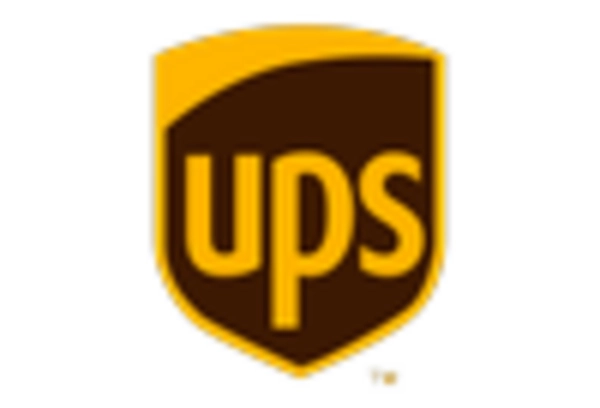Rising Consumer Expectations
The is experiencing a surge in consumer expectations regarding delivery speed and service quality. With the proliferation of online shopping, consumers increasingly demand faster shipping options, often expecting same-day or next-day delivery. This trend is reflected in a recent survey indicating that 75% of consumers prioritize delivery speed when choosing an online retailer. As a result, logistics providers are compelled to enhance their operational efficiencies and invest in advanced technologies to meet these expectations. The pressure to deliver exceptional service is likely to drive innovation within the e commerce-logistics market, as companies seek to differentiate themselves in a competitive landscape.
Expansion of E Commerce Platforms
The e commerce-logistics market is benefiting from the rapid expansion of e commerce platforms across various sectors. As more businesses establish an online presence, the demand for efficient logistics solutions is intensifying. In 2025, e commerce sales in the US are projected to reach approximately $1 trillion, highlighting the growing reliance on logistics services to facilitate these transactions. This expansion necessitates the development of robust logistics networks capable of handling increased order volumes and ensuring timely deliveries. Consequently, logistics providers are likely to invest in infrastructure and technology to support the evolving needs of the e commerce-logistics market.
Advancements in Automation and Robotics
The e commerce-logistics market is witnessing significant advancements in automation and robotics, which are transforming traditional logistics operations. Automated warehouses and robotic sorting systems are becoming increasingly prevalent, enabling companies to streamline their processes and reduce operational costs. For instance, the adoption of automated systems can lead to a reduction in labor costs by up to 30%, thereby enhancing profitability. As logistics providers integrate these technologies, they are likely to improve order accuracy and speed, ultimately benefiting the e commerce-logistics market. This trend suggests a shift towards more efficient and scalable logistics solutions.
Regulatory Changes and Compliance Requirements
The e commerce-logistics market is navigating a complex landscape of regulatory changes and compliance requirements that impact logistics operations. Recent legislation aimed at improving transportation safety and environmental standards is influencing how logistics providers operate. For example, new regulations may require companies to adopt greener practices, which could involve significant investments in sustainable technologies. Compliance with these regulations is essential for maintaining operational licenses and avoiding penalties. As the regulatory environment continues to evolve, logistics providers must adapt their strategies to ensure compliance, which may drive innovation and operational improvements within the e commerce-logistics market.
Increased Focus on Last-Mile Delivery Solutions
The is placing a heightened emphasis on last-mile delivery solutions, which are critical for customer satisfaction. Last-mile delivery represents the final step in the logistics process, and its efficiency can significantly impact the overall customer experience. With the rise of urbanization and changing consumer behaviors, logistics providers are exploring innovative last-mile delivery options, such as crowd-sourced delivery and autonomous vehicles. This focus on last-mile solutions is expected to grow, as companies strive to enhance delivery speed and reduce costs, thereby shaping the future of the e commerce-logistics market.

















Leave a Comment